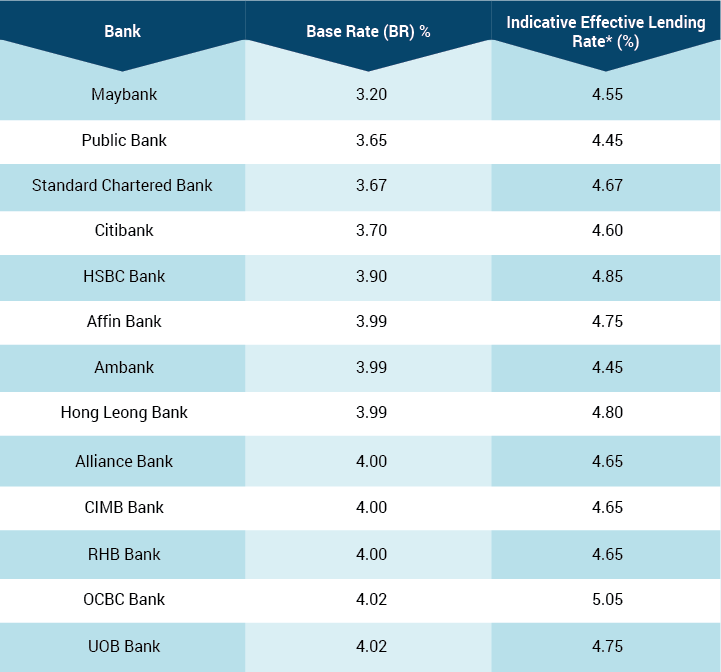Effective January 2, 2015, the Base Lending Rate (BLR) structure was replaced with a new Base Rate (BR) system. Under BR, which will now serve as the main reference rate for new retailfloating rate loans, banks in Malaysia can determine their interest rate based on a formula set by the central bank.
Under the previous BLR, the rate was set by Bank Negara Malaysia (BNM) based on how much it costs to lend money to other financial institutions. Meanwhile, the cost to borrow money was determined by the Overnight Policy Rate (OPR) set by central bank.
With the new BR, interest rates are determined by the banks' benchmark cost of funds and Statutory Reserve Requirement (SRR). Other components of loan pricing such as borrower creditrisk, liquidity risk premium, operating costs and profit margin will be reflected in a spread in the new BR framework.
Why the change?Instead of a fixed rate under BLR, BR are determined by banks without intervention by the central bank, and should differ from bank to bank depending on their own efficiencies in lending. Banks with a strong niche in consumer financing such as Maybank and Public Bank will have the initial edge of being able to offer more attractive and competitive BR and effective lending rates (ELR) for their customers.
The new framework encourages greater transparency from banks and will enable customers to make better financial decisions. Previously, calculations of BLR lacked transparency and some banks were lending below the BLR to attract customers and boost loan growth. Under the new system, customers cannot borrow below the base rate.

The change towards the new framework should have minimum impact on borrowers. Take the rates offered by Maybank for example. Based on the previous BLR rate of 6.85%, the "BLR -2.40%" offer means that the customer pays 4.45% on the mortgage.
With the BR system, the bank will have to reveal its base rate and also disclose its margin, which will determine the ELR. Maybank has set its Base Rate (BR) at 3.20%. Here, interest is presented as "base rate +1.35%", which means that the effective rate that the customer will have to pay on the mortgage is 4.55%.
Ultimately, it's the ELR that will determine how much you will have to pay for your mortgage. Here is a comparison of how much you will be paying for your home loan under BLR and under BR.

With the new framework, a home loan borrower of Maybank may have to pay an additional RM34 a month, which amounts to RM12,240 more by the end of the loan tenure.
Though certain banks may be setting a higher BR compared to others, they can sometimes offer lower ELR to customers in order to remain competitive. For example, Public Bank has a BR of 3.65% while Maybank's is 3.20%. However, Public Bank offers a lower ELR at 4.45%, while Maybank's ELR is 4.55%. This essentially means that Public Bank is willing to take a smaller profit margin in order to be more competitive.
Loans that are already approved and extended prior to January 2, 2015 will still follow the old BLR until the end of the loan tenure.
For new loan applicants and refinancing applicants, the new BR framework will have a direct impact on interest rates with effect from the date. Banks are still required to display both BLR and BR on their branches and websites.
What happens now?Better transparency will create healthy competition among banks and provide a wider range of options for loan applicants. According to BNM, the new reference rate will also better reflect changes in cost arising from monetary policy and market funding conditions, while encouraging greater discipline and efficiency among financial institutions in the pricing of retail financing products.
Also, because the base rates are managed by individual banks, this will force banks to come up with more cost-efficient rates in order to compete with each other and create a much more competitive market.
However, given the flexibility to determine their respective benchmark rates, smaller institutions may risk losing out on the race of getting more borrowers for loans.
Bigger establishments will have more room to maneuver when determining the reference rates, whereas smaller institutions may not have as much leeway to offer competitive rates. However, loan rates will still depend on the management's risk appetite at the end of the day.
For the customer, a more transparent reference rate will enable them to make better money choices when it comes to navigating an array of loan products offered by various financial institutions. Customers with a higher risk profile such as those with bad credit, low income or poor employment histories will enable the bank to set the ELR higher and make a more profitable net interest margin (NIM). However, this could result in potentially higher default rates in the future.
Home buyers can keep ahead with the rates (new and old) by comparing all the best home loan rates from the banks before making a decision on which loan to apply for. By doing thorough and adequate research, you can remove some of the intimidation factor from the home-buying process.


